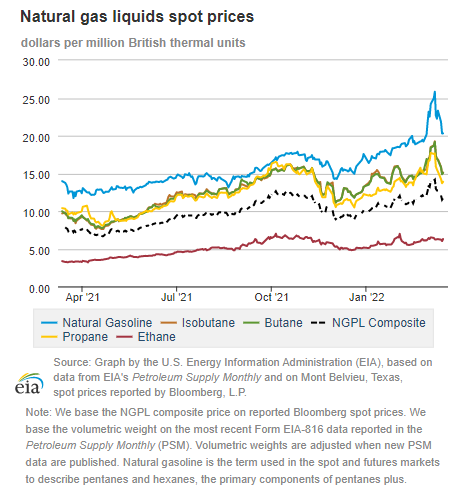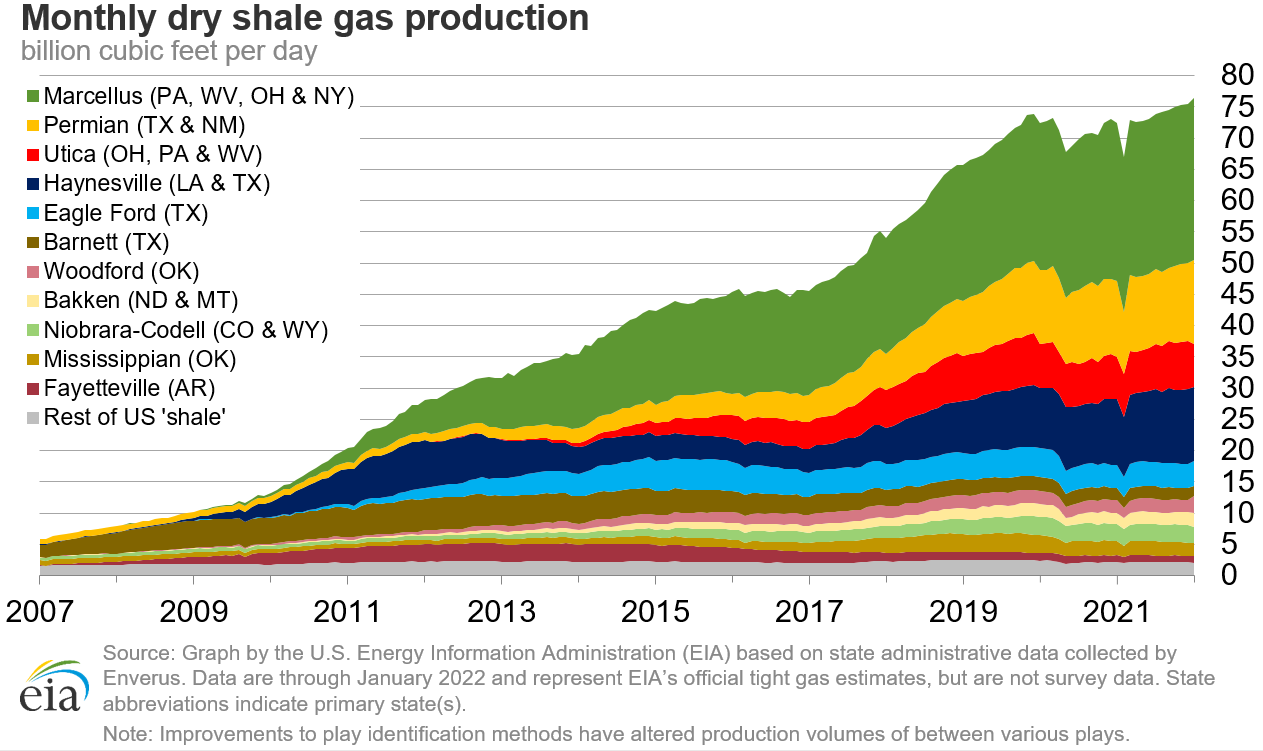In the News:
U.S. LNG exports set a new record high 2021, growing by 50% compared with 2020
U.S. exports of liquefied natural gas (LNG) set a new record high in 2021, averaging 9.7 billion cubic feet per day (Bcf/d)—an increase of 3.2 Bcf/d (50%) compared with the 2020 annual average, according to our recently published Natural Gas Monthly. The increase in U.S. LNG exports was driven by increased demand in both Europe and Asia (particularly China), as well as by expanding U.S. liquefaction capacity. In 2021, annual utilization of liquefaction capacity at the six U.S. LNG export terminals averaged 102% of nameplate (or nominal) capacity and 89% of peak capacity, according to our estimates.
U.S. LNG exports to Asia increased by 1.5 Bcf/d (51%) compared with 2020 and accounted for the largest share of all U.S. LNG exports at 47% (4.6 Bcf/d)—the same share as in 2020. Last year, the United States became the third-largest LNG supplier to Asia, accounting for 12% of total LNG imports into Asia, after Australia and Qatar, which supplied 10.3 Bcf/d (29%) and 7.4 Bcf/d (21%), respectively, according to our estimates based on data from CEDIGAZ.
Among Asian countries, South Korea and China were the top two destinations for U.S. LNG exports at 1.2 Bcf/d each; South Korea imported only 10 million cubic feet per day (MMcf/d) (0.8%) more than China. Last year, China more than doubled its LNG imports from the United States compared with 2020—an increase of more than 0.6 Bcf/d—the largest volumetric increase among all importers of U.S. LNG globally. China has been increasing imports of U.S. LNG every year since China lowered tariffs on imports of LNG from the United States from 25% to 10% in 2019. Japan was the third-largest importer of U.S. LNG in Asia in 2021 at 1.0 Bcf/d. Combined, these three countries accounted for 75% of U.S. LNG exports to Asia and 35% of the total exports last year.
European countries (including Turkey) imported 3.3 Bcf/d of LNG from the United States—an increase of 0.8 Bcf/d (32%) compared with 2020—and accounted for 34% of total U.S. LNG exports. U.S. LNG exports to Europe increased from February to April in 2021 following a cold winter and low storage inventories at the end of the heating season. Exports declined in subsequent months as higher spot prices in Asia attracted larger volumes of flexible U.S. LNG supplies to Asia. In the fourth quarter of 2021, U.S. LNG exports to Europe increased again as European natural gas storage inventories remained low and spot prices in Europe exceeded Asian spot prices. LNG exports from the United States to Europe averaged 6.7 Bcf/d in December—the highest monthly export volume to Europe from 2016 to 2021. The largest increase in exports was to the Netherlands and France (up by 0.2 Bcf/d each), followed by Turkey and the United Kingdom.
Ten other countries accounted for the remaining 19% (1.8 Bcf/d) of total U.S. LNG exports in 2021, led by Brazil. U.S. LNG exports to Brazil increased by 0.5 Bcf/d compared with 2020, and averaged 0.8 Bcf/d on an annual basis. Last year, Brazil experienced its worst drought in more than 90 years, which limited hydroelectric power generation and required higher volume of natural gas imports to generate electricity by natural gas-fired power plants.
Overview:
(For the week ending Wednesday, March 16, 2022)
- Spot Prices: Natural gas spot prices fell at most locations this report week (Wednesday, March 9 to Wednesday, March 16). The Henry Hub spot price rose from $4.56 per million British thermal units (MMBtu) last Wednesday to $4.67/MMBtu yesterday. Prices at major hubs settled within a band of $1.26/MMBtu yesterday. They ranged from a high of $5.14/MMBtu at PG&E Citygate in California to a low of $3.88/MMBtu in New York, according to data from Natural Gas Intelligence. The Henry Hub price was the second highest of the major pricing hubs.
- International Spot Prices: International natural gas spot prices declined this report week but have remained elevated since the start of Russia’s further invasion of Ukraine on February 24, which has increased uncertainty in European natural gas markets. Bloomberg Finance, L.P. reports that swap prices for liquefied natural gas (LNG) cargos in East Asia for the balance of March fell $1.79/MMBtu to a weekly average of $38.62/MMBtu. At the Title Transfer Facility (TTF) in the Netherlands, the most liquid natural gas spot market in Europe, the day-ahead prices fell $22.29 to a weekly average of $37.47/MMBtu. In the same week last year (week ending March 17, 2021), prices in East Asia and at TTF were $6.21/MMBtu and $6.42/MMBtu, respectively.
- Futures: The price of the April 2022 NYMEX contract increased 22.2 cents, from $4.526/MMBtu last Wednesday to $4.748/MMBtu yesterday. The price of the 12-month strip averaging April 2022 through March 2023 futures contracts climbed 19.8 cents to $4.894/MMBtu.
- Storage: The net withdrawals from working gas totaled 79 billion cubic feet (Bcf) for the week ending March 11. Working natural gas stocks totaled 1,440 Bcf, which is 19% lower than the year-ago level and 17% lower than the five-year (2017–2021) average for this week.
- NGPLs: The natural gas plant liquids composite price at Mont Belvieu, Texas, fell by $1.52/MMBtu, averaging $12.15/MMBtu for the week ending March 16. Brent crude oil prices fell 13%, putting downward pressure on the prices of natural gasoline, isobutane, normal butane, and propane. The natural gasoline price fell 10%, and the price of isobutane and normal butane each fell 12%. The propane price fell 15%. The ethane price fell 2%, following the 3% decrease in natural gas prices at the Houston Ship Channel. The ethane premium over natural gas remained relatively unchanged. The price of ethylene fell 9%, narrowing the price spread between ethylene and ethane by 13% this week.
- Rigs: According to Baker Hughes, for the week ending Tuesday, March 8, the natural gas rig count increased by 5 to 135 rigs. The Haynesville added two rigs, the Utica added one rig, and two rigs were added in unspecified locations. The number of oil-directed rigs increased by 8 to 527 rigs. The Permian Basin added six rigs, and the Eagle Ford added two rigs. The total rig count now stands at 663, the highest level since April 3, 2020, and 261 rigs more than last year at this time.
Prices/Supply/Demand:
Prices on the Gulf Coast rise slightly with colder-than-normal temperatures. The Henry Hub spot price rose 11 cents from $4.56 per million British thermal units (MMBtu) last Wednesday to $4.67/MMBtu yesterday. Across the Southeast region, residential and commercial consumption increased by 1.5 Bcf/d (74%). Temperatures along the Gulf Coast were colder than normal this report week. In Houston, Texas, the average temperature was 57°F, which was 7°F lower than normal.
Feedgas deliveries to LNG export terminals in South Texas decreased 0.1 Bcf/d (3%) to 4.0 Bcf/d, while feedgas deliveries to LNG terminals in South Louisiana increased by almost 0.3 Bcf/d (4%) to 7.7 Bcf/d, according to data from PointLogic. Venture Global, operator of the Calcasieu Pass LNG export terminal, received two authorizations from the Federal Energy Regulatory Commission (FERC) this week: 1) approval to commission Block 5 and the Feed Gas Booster Compressor B; and 2) approval to introduce hazardous fluids to the north LNG storage tank. Deliveries of natural gas to the terminal continued to rise this week, averaging close to 0.7 Bcf/d according to TransCameron, the operator of the pipeline delivering gas to Calcasieu Pass. Cheniere, operator of the Corpus Christi Pipeline, announced planned maintenance at its Sinton Compressor Station in San Patricio County in South Texas, upstream of the Corpus Christi LNG terminal. The work was scheduled to begin Monday, March 14, and to last about a week. Nominations have decreased as a result by slightly more than 0.5 Bcf/d from March 13 to March 16. Over the same period, feedgas to Corpus Christi LNG has fallen as well, by almost 0.8 Bcf/d, according to Cheniere. Cheniere’s Sabine Pass terminal received FERC conditional approval on March 9, 2022, to recommission, cool down, and place into service a storage tank that was shut down in 2018 following a leak.
Prices in the Midwest fall in response to rapidly rising temperatures. At the Chicago Citygate, the price decreased 26 cents from $4.47/MMBtu last Wednesday to $4.21/MMBtu yesterday. Temperatures in the Chicago area averaged 36°F over the course of the report week, 2°F below normal for the week, driving weekly average natural gas consumption higher. In the Midwest, residential and commercial natural gas consumption increased by 0.5 Bcf/d (6%), consumption in the electric power generation sector increased by 0.2 Bcf/d (9%), and consumption by the industrial sector increased by 0.2 Bcf/d (4%) this report week, according to data from PointLogic. However, the weather turned yesterday. NOAA reports Chicago-area temperatures averaged 53°F yesterday, which was 8°F higher than on Tuesday and almost 14°F above normal, with the daily high reaching 70°F, the highest for the month. Just four days before, on March 12, nighttime temperatures dropped to a monthly low of 11°F and averaged 17°F for the day, almost 21°F below normal. Warmer-than-normal temperatures are expected to persist in the region through the weekend.
Prices in the West fall as temperatures rise. The price at PG&E Citygate in Northern California fell 17 cents, down from $5.31/MMBtu last Wednesday to $5.14/MMBtu yesterday, reflecting falling prices in regions supplying natural gas into Northern California. The price at Malin, Oregon, the northern delivery point into the PG&E service territory, fell 19 cents from $4.35/MMBtu last Wednesday to $4.16/MMBtu yesterday. The price at Sumas on the Canada-Washington border fell 24 cents from $4.15/MMBtu last Wednesday to $3.91/MMBtu yesterday. Total consumption of natural gas in the Pacific Northwest decreased by 0.3 Bcf/d (13%) this report week, according to data from PointLogic, as temperatures in Seattle, Washington, averaged nearly 47°F, which is 3°F higher than last report week. The price at SoCal Citygate in Southern California decreased 52 cents from $4.74/MMBtu last Wednesday to $4.22/MMBtu yesterday, reflecting falling demand and lower prices in the Permian Basin, the main supply region into Southern California (the Waha price discussion provides more detail below). Residential and commercial natural gas consumption in California decreased by 0.6 Bcf/d (23%) this report week, according to data from PointLogic. NOAA reports temperatures in Riverside, California, inland from Los Angeles, averaged 62°F this report week, 3°F higher than normal, resulting in 20 heating degree days (HDDs) compared with 68 HDDs last report week.
Prices across the Northeast decline in advance of warming temperatures. At the Algonquin Citygate, which serves Boston-area consumers, the price decreased 60 cents from $4.61/MMBtu last Wednesday to $4.01/MMBtu yesterday. A sign that the heating season in New England is coming to an end, the Algonquin Citygate traded 66 cents below the Henry Hub price yesterday, compared with January 19, 2022, when it traded $17.95 above the Henry Hub. Temperatures in the Boston area fluctuated widely this week, ranging from a daily low of 22°F on Sunday to a daily high of 59°F on Tuesday, and are forecast to be warmer than normal heading into the weekend. Natural gas demand in New England was down about 0.2 Bcf/d (5%) to an average of 3.0 Bcf/d this week, according to data from PointLogic. At the Transcontinental Pipeline Zone 6 trading point for New York City, the price decreased 37 cents from $4.25/MMBtu last Wednesday to $3.88/MMBtu yesterday. Natural gas demand in the New York and New Jersey area declined about 0.2 Bcf/d (2%) to 9.8 Bcf/d.
Prices in the Appalachia production region fall in line with neighboring regions. The Tennessee Zone 4 Marcellus spot price decreased 34 cents from $4.06/MMBtu last Wednesday to $3.72/MMBtu yesterday. The price at Eastern Gas South in southwest Pennsylvania fell 30 cents from $4.08/MMBtu last Wednesday to $3.78/MMBtu yesterday. Net natural gas flows out of the region declined 0.9 Bcf/d (3%) to average 26.7 Bcf/d, according to data from PointLogic.
Prices in the Permian production region fall in response to decreasing demand outside the region. The price at the Waha Hub in West Texas, which is located near Permian Basin production activities, fell 60 cents this report week, from $4.25/MMBtu last Wednesday to $3.65/MMBtu yesterday. The Waha Hub traded $1.02 below the Henry Hub price yesterday, compared with last Wednesday when it traded 31 cents below the Henry Hub price. Total production fell 0.3 Bcf/d (2%) from a week ago to average 14.3 Bcf/d, according to data from PointLogic. As a result of lower demand outside the region, net natural gas flows out of the region decreased 0.4 Bcf/d (3%) to average 13.1 Bcf/d for the week.
U.S. average total natural gas supply falls this week. Average total supply of natural gas fell by 0.9% (0.9 Bcf/d) compared with the previous report week, according to data from PointLogic. Dry natural gas production decreased week over week by 1.1% (1.0 Bcf/d) compared with the previous report week while average net imports from Canada increased by 2.1% (0.1 Bcf/d) from last week.
U.S. total natural gas consumption increases this week across all sectors. Total U.S. consumption of natural gas rose by 3.2% (2.7 Bcf/d) on average this report week compared with the previous report week, with all sectors showing increases, according to data from PointLogic. The largest week-over-week increase was in the residential and commercial sector, where consumption increased 6.4% (2.0 Bcf/d) as temperatures across the United States were noticeably cooler than normal, as reported by NOAA. Natural gas consumed for power generation climbed by 1.1% (0.3 Bcf/d) week over week and industrial sector consumption increased by 1.5% (0.3 Bcf/d). Natural gas exports to Mexico increased slightly (0.2%) while natural gas deliveries to U.S. LNG export facilities (LNG pipeline receipts) averaged 12.9 Bcf/d, or 0.1 Bcf/d higher than the previous report week.
U.S. LNG exports decrease by one vessel this week from last week. Twenty-two LNG vessels (nine from Sabine Pass, four each from Cameron, Corpus Christi, and Freeport, and one from Cove Point) with a combined LNG-carrying capacity of 82 Bcf departed the United States between March 10 and March 16, according to shipping data provided by Bloomberg Finance, L.P.
Storage:
The net withdrawals from storage totaled 79 Bcf for the week ending March 11, compared with the five-year (2017–2021) average net withdrawals of 65 Bcf and last year's net withdrawals of 16 Bcf during the same week. Working natural gas stocks totaled 1,440 Bcf, which is 304 Bcf lower than the five-year average and 344 Bcf lower than last year at this time.
According to The Desk survey of natural gas analysts, estimates of the weekly net change to working natural gas stocks ranged from net withdrawals of 56 Bcf to 87 Bcf, with a median estimate of 73 Bcf.
The average rate of withdrawals from storage is 10% higher than the five-year average at this point in the withdrawal season (November through March). If the rate of withdrawals from storage matched the five-year average of 3.9 Bcf/d for the remainder of the withdrawal season, the total inventory would be 1,362 Bcf on March 31, which is 304 Bcf lower than the five-year average of 1,666 Bcf for that time of year.
More storage data and analysis can be found on the Natural Gas Storage Dashboard and the Weekly Natural Gas Storage Report.
See also:
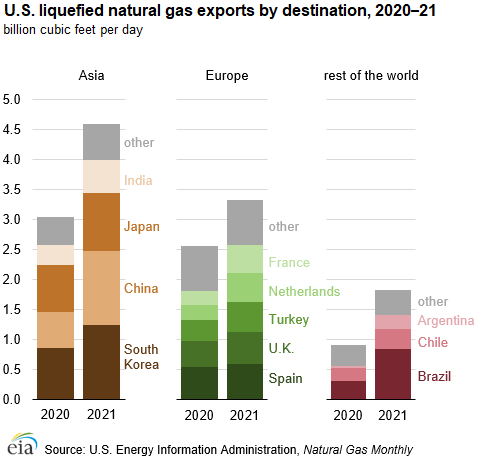
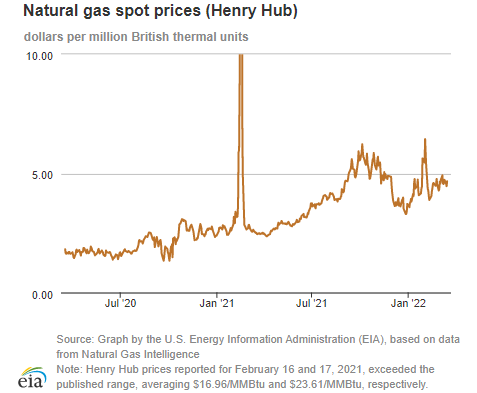
| Spot Prices ($/MMBtu) | Thu, 10-Mar |
Fri, 11-Mar |
Mon, 14-Mar |
Tue, 15-Mar |
Wed, 16-Mar |
|---|---|---|---|---|---|
| Henry Hub |
4.60 |
4.73 |
4.58 |
4.47 |
4.67 |
| New York |
4.11 |
5.64 |
4.00 |
3.79 |
3.88 |
| Chicago |
4.50 |
4.56 |
4.27 |
4.22 |
4.21 |
| Cal. Comp. Avg.* |
4.69 |
4.60 |
4.45 |
4.33 |
4.45 |
| Futures ($/MMBtu) | |||||
| April contract | 4.631 |
4.725 |
4.658 |
4.568 |
4.748 |
| May contract |
4.669 |
4.766 |
4.702 |
4.617 |
4.784 |
| *Avg. of NGI's reported prices for: Malin, PG&E Citygate, and Southern California Border Avg. | |||||
| Source: NGI's Daily Gas Price Index | |||||
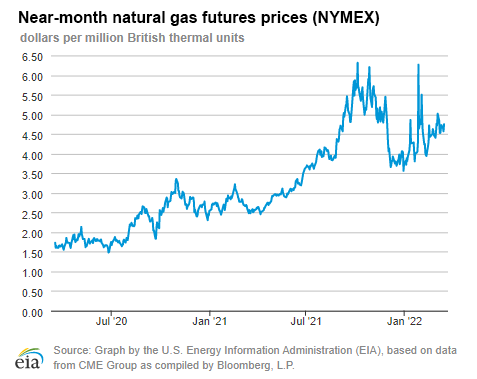
| U.S. natural gas supply - Gas Week: (3/10/22 - 3/16/22) | |||
|---|---|---|---|
Average daily values (billion cubic feet) |
|||
this week |
last week |
last year |
|
| Marketed production | 105.1 |
106.3 |
103.5 |
| Dry production | 93.0 |
94.0 |
91.3 |
| Net Canada imports | 5.0 |
4.9 |
4.4 |
| LNG pipeline deliveries | 0.1 |
0.1 |
0.1 |
| Total supply | 98.1 |
99.0 |
95.8 |
|
Source: Chart by the U.S. Energy Information Administration (EIA), based on data from PointLogic | |||
| U.S. natural gas consumption - Gas Week: (3/10/22 - 3/16/22) | |||
|---|---|---|---|
Average daily values (billion cubic feet) |
|||
this week |
last week |
last year |
|
| U.S. consumption | 85.0 |
82.4 |
73.7 |
| Power | 26.9 |
26.6 |
23.5 |
| Industrial | 24.2 |
23.9 |
22.2 |
| Residential/commercial | 33.9 |
31.9 |
28.0 |
| Mexico exports | 5.7 |
5.7 |
5.6 |
| Pipeline fuel use/losses | 6.9 |
6.8 |
6.4 |
| LNG pipeline receipts | 12.9 |
12.8 |
10.9 |
| Total demand | 110.5 |
107.6 |
96.6 |
|
Source: Chart by the U.S. Energy Information Administration (EIA), based on data from PointLogic | |||
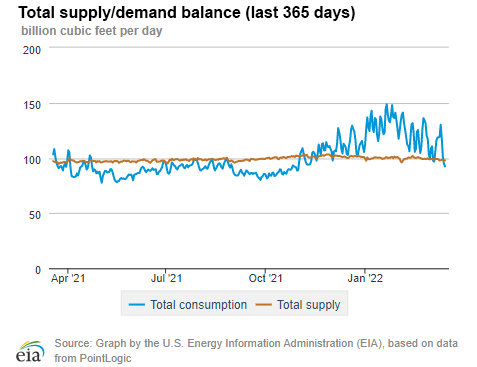
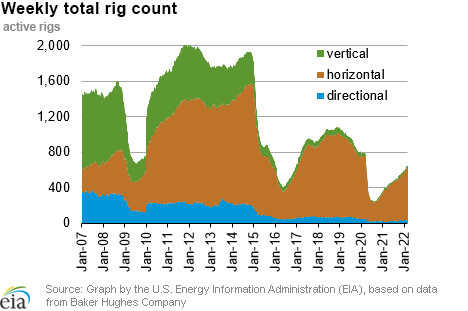
| Rigs | |||
|---|---|---|---|
Tue, March 08, 2022 |
Change from |
||
last week |
last year |
||
| Oil rigs | 527 |
1.5% |
70.6% |
| Natural gas rigs | 135 |
3.8% |
46.7% |
| Note: Excludes any miscellaneous rigs | |||
| Rig numbers by type | |||
|---|---|---|---|
Tue, March 08, 2022 |
Change from |
||
last week |
last year |
||
| Vertical | 23 |
-8.0% |
-8.0% |
| Horizontal | 607 |
2.0% |
67.7% |
| Directional | 33 |
10.0% |
120.0% |
| Source: Chart by the U.S. Energy Information Administration (EIA), based on data from Baker Hughes Company | |||
| Working gas in underground storage | ||||
|---|---|---|---|---|
Stocks billion cubic feet (Bcf) |
||||
| Region | 2022-03-11 |
2022-03-04 |
change |
|
| East | 290 |
317 |
-27 |
|
| Midwest | 337 |
364 |
-27 |
|
| Mountain | 87 |
93 |
-6 |
|
| Pacific | 155 |
162 |
-7 |
|
| South Central | 571 |
582 |
-11 |
|
| Total | 1,440 |
1,519 |
-79 |
|
|
Source: U.S. Energy Information Administration Form EIA-912, Weekly Underground Natural Gas Storage Report | ||||
| Working gas in underground storage | |||||
|---|---|---|---|---|---|
Historical comparisons |
|||||
Year ago (3/11/21) |
5-year average (2017-2021) |
||||
| Region | Stocks (Bcf) |
% change |
Stocks (Bcf) |
% change |
|
| East | 331 |
-12.4 |
333 |
-12.9 |
|
| Midwest | 428 |
-21.3 |
423 |
-20.3 |
|
| Mountain | 114 |
-23.7 |
101 |
-13.9 |
|
| Pacific | 200 |
-22.5 |
174 |
-10.9 |
|
| South Central | 711 |
-19.7 |
713 |
-19.9 |
|
| Total | 1,784 |
-19.3 |
1,744 |
-17.4 |
|
| Source: U.S. Energy Information Administration Form EIA-912, Weekly Underground Natural Gas Storage Report | |||||
| Temperature – heating & cooling degree days (week ending Mar 10) | ||||||||
|---|---|---|---|---|---|---|---|---|
HDDs |
CDDs |
|||||||
| Region | Current total |
Deviation from normal |
Deviation from last year |
Current total |
Deviation from normal |
Deviation from last year |
||
| New England | 204 |
-16 |
-30 |
0 |
0 |
0 |
||
| Middle Atlantic | 179 |
-28 |
-35 |
0 |
0 |
0 |
||
| E N Central | 193 |
-25 |
18 |
0 |
-1 |
0 |
||
| W N Central | 241 |
23 |
114 |
0 |
-1 |
0 |
||
| South Atlantic | 79 |
-47 |
-52 |
20 |
10 |
15 |
||
| E S Central | 73 |
-48 |
-40 |
3 |
-1 |
3 |
||
| W S Central | 81 |
5 |
22 |
12 |
3 |
6 |
||
| Mountain | 225 |
56 |
86 |
0 |
-1 |
-2 |
||
| Pacific | 120 |
26 |
1 |
0 |
-1 |
0 |
||
| United States | 157 |
-7 |
10 |
5 |
2 |
3 |
||
|
Source: Chart by the U.S. Energy Information Administration (EIA), based on data from the National Oceanic and Atmospheric Administration Note: HDDs=heating degree days; CDDs=cooling degree days | ||||||||
Average temperature (°F)
7-day mean ending Mar 10, 2022
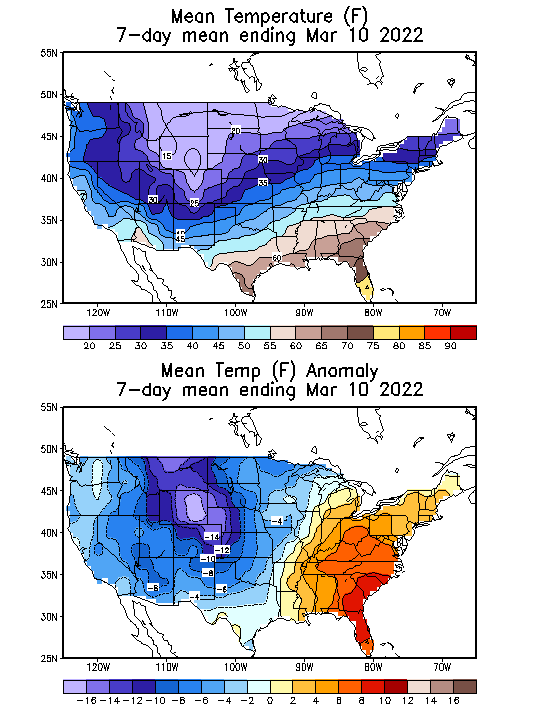
Source: National Oceanic and Atmospheric Administration Note: Image is not available.
Deviation between average and normal (°F)
7-day mean ending Mar 10, 2022

Source: National Oceanic and Atmospheric Administration Note: Image is not available.

